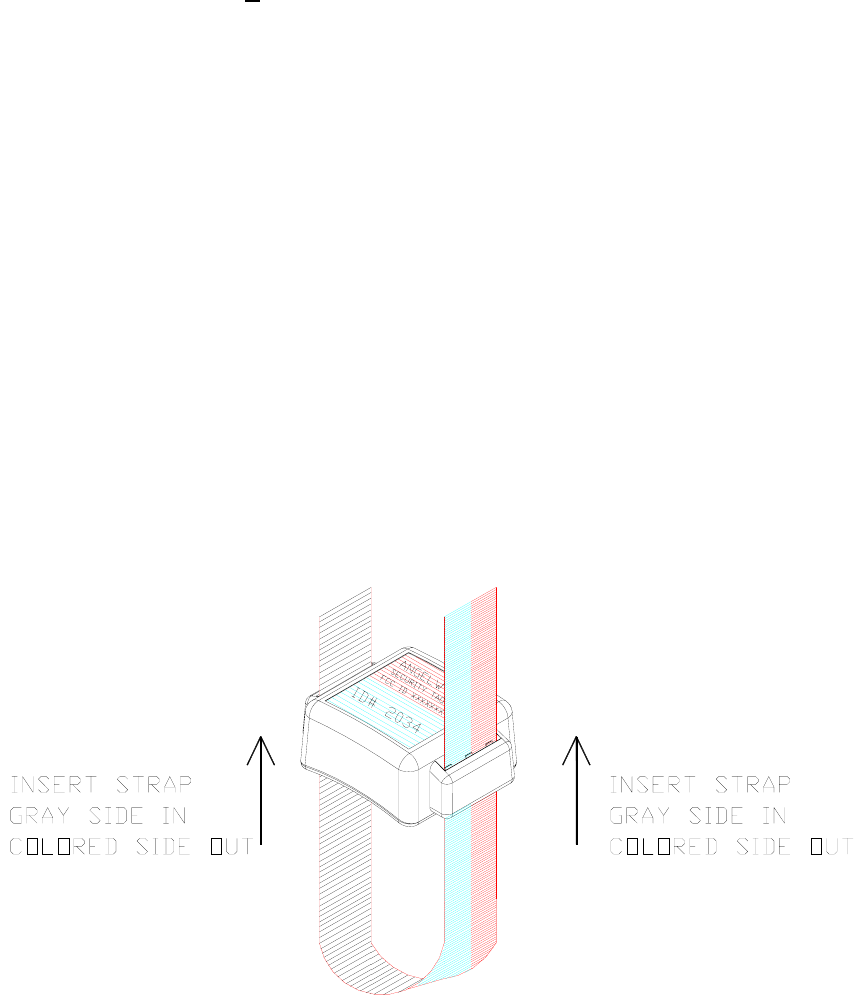Securitas America SBA-2000 Security Transmitter User Manual SECURITAS AMERICA INC
Securitas America, Inc. Security Transmitter SECURITAS AMERICA INC
Users Manuel
SECURITAS AMERICA, INC.
ANGELWATCHTM
INFANT PROTECTION SYSTEM
OPERATION MANUAL
© Copyright 2001 Securitas America, Inc.
All rights reserved
Securitas America, Inc.
552 NW 77th Street
Boca Raton, FL 33487
Phone: 561-989-3608 Fax: 561-997-6923
09-12-02 Revision 3.3
TABLE OF CONTENTS
Cover …………………………………………………………… i
Table of Contents ………………………………………………. ii
1. INTRODUCTION ….……………………………………………………... .. 1
Overview of System …...……………………………………………… …… 1
Equipment ……………………………………………………………… . 2
Starting the System ....………………………………………………….. … 3
System Display …..…………………………………………………… . … 3
2. MAINTENANCE COMMANDS .…………………………………………. 4
File ……………………………………………………………... . ………… 5
Set System Parameters ……..………………………………………….. … 6
Edit Maintenance Passwords..………………………………………….. … 7
Edit Administrator Passwords..………………………………………….. … 8
Edit Receiver List …………………………………………………………. 9
Receiver Test …………………………………………………………….… 9
Edit Remote List …………………………………………………………. 11
Remote Test …………………………………………………………….… 12
3. ADMINISTRATOR COMMANDS ……………………………………….. 14
Edit Passwords ……………………………………………………...……… 14
Reports ……………………………………………………………………... 15
Backup ……………………………………………………………………... 15
4. SUPERVISOR COMMANDS …………………………………………….. 16
Lock Doors ……………………………………………………………..…… 16
Unlock Doors …………………………………………………….………… 16
Clear All Alarms ………………………………………………………….... 17
5. USER COMMANDS……………………………………………………….. 17
Login New Patient ………………………………………………………….. 18
Excuse Patient ………………………………………………....…………… 19
Re-Enter Patient …………………………………………………... ……… 20
Discharge Patient …………………………………………………………… 21
6. THE ANGELWATCH SMARTBAND ANKLET………………………….. 23
7. THE ANGELWATCH REUSABLE TAG……...………………………….. 24
ii
1. INTRODUCTION
Overview of System
The PC Based Angelwatch™ Infant Protection System is designed to monitor the
location of infants who are wearing a special Angelwatch SmartBand anklet. This anklet
is an active transmitter that allows the system to continuously monitor the presence of the
infant and the status of the anklet band itself.
The SmartBand anklet (Model # SBA-1000) transmits its identification and status.
These transmissions are detected by receivers located throughout the area to be
monitored. Three types of receivers are used to provide full coverage. The receivers are
similar, the difference is what they detect and what they do afterwards.
The Internal locating receivers (Model # INR-1000) are used to cover the entire area
to be secured. The Internal locating receivers are designed to send an alarm whenever the
signal from the anklet is lost. This indicates that the baby has been moved outside the
coverage area or that the anklet has been disabled. The Internal locating receivers also
detect the signal from a anklet that has been broken or cut so the system can activate the
appropriate alarm.
The Exit receiver (Model # EXR-1000) is a receiver located at any exit from the
coverage area. Whenever an Exit receiver detects the signal from an anklet, an alarm is
set indicating that the baby is being taken out the indicated entrance. This alarm can be
used to activate a camera. Because of the area covered and the fact that the system
activates an alarm whenever the Exit receiver detects an anklet, it is not recommended for
use as an exit control.
The Locking receiver (also Model # EXR-1000) is a receiver specifically configured
to control exits. When this receiver detects an anklet, it activates its output but does not
set an alarm. This allows the receiver to be used in high traffic areas to control an exit.
The exit locks will be set whenever the receiver detects an anklet, but will not set an
alarm in case the anklet is still in an allowed area. It is best to back these receivers up
with Exit receivers outside the exits so that if an infant is taken through the exit, an alarm
will then be set.
By themselves, these three types of receiver provide a great deal of security. How-
ever, someone trying to abduct a baby may realize that the anklet is part of the security
system and try to remove it. If the anklet is cut, it instantly sends out a signal indicating it
has been cut. This helps to ensure that the baby is constantly monitored.
1

Equipment
A variety of equipment is used to make up an Angelwatch system. The equipment
actually installed at a site will vary depending on the needs of that particular hospital.
Workstations
The Angelwatch system is based around a small computer running the system soft-
ware. This computer is called the Master Workstation (Model # MWS-1000) and all the
receivers and Remote Workstations are connected to it. The computer uses Microsoft
Windows 2000 as an operating system. In addition, the computer is equipped with an
Uninterruptible Power Supply (Model # UPS-1000) to ensure that the system will
continue to operate if power is interrupted.
In addition to the Master Workstation, up to sixteen Remote Workstations (Model #
RWS-1000) may be connected. The use of Remote Workstations allows use of the system
and displays alarm conditions from several locations within the facility.
Receivers
The receivers are connected to the system using an RS-485 serial data network. This
allows up to 255 receivers to be connected to the Master Workstation. There are three
types of receivers available for use with the system. The receivers are powered by 12
volts DC from custom wall mounted enclosure(s) that contain an Un-interruptible Power
Supply (UPS) and the necessary hardware engineered for that particular system
The Internal Locating Receivers (Model # INR-1000) are used to monitor the
presence and status of the anklets. The number of INR’s varies by site. The INR receiver
will set an alarm if it loses the signal from the anklet and no other receiver has detected it,
or the anklet is cut while being monitored. The lost band time is set to 60 seconds at the
factory, however, this default time can be changed by personnel that have access to the
Maintenance Commands menu.
Exit Receivers (Model # EXR-1000) are used to monitor entrances and exits from the
area in which the anklets are allowed. The Exit Receiver will only set an alarm when it
detects an anklet within its coverage area indicating that a monitored infant is in an exit
area.
Locking receivers (also Model # EXR-1000) do not set an alarm on the system. This
receiver has the ability to activate a door lock whenever it detects an anklet and is
interfaced with magnetic door locks.
There may be occasions where a hospital will want a receiver to do more than set an
alarm. This is especially true of the Exit Receivers, where hospitals may want them to
activate a security camera or tie to another security system. Angelwatch Receivers have
a small low power internal relay (form C dry contacts) which is activated whenever an
alarm is set. The Internal locating receivers (INR1000) activate for all alarms. Exit
Receivers (EXR1000) activate when that particular exit is violated.
The Angelwatch SmartBand Anklet
The Angelwatch SmartBand Anklet (Model # SBA-1000) is the heart of the system.
This anklet transmits a code to the receivers that is used to monitor the infant. Alarms are
set when a band is lost, broken or detected by an Exit Receiver. The anklet is designed
for a single use and is then discarded.
2
The Angelwatch Reusable Tag
The Angelwatch Reusable Tag (Model # TAG-1000) is the latest addition to the
system. This tag transmits a code to the receivers that is used to monitor the infant.
Alarms are set when a tag is lost, or the strap is broken, or the tag is detected by an Exit
Receiver. The transmitter tag is designed to be cleaned and reused. Each strap is designed
for a single use and is then discarded.
Starting the System
The Angelwatch Master Workstation operating system is Microsoft Windows 2000.
When it is turned on or rebooted, it will run through a series of tests and then automati-
cally start the Angelwatch software. However, it may be necessary to terminate the sys-
tem, which will result in the operator looking at a standard Windows desktop.
To start the Angelwatch software from a standard Windows desktop, position your
pointer at the Angel icon and Double left click the icon. The software will start and
immediately begin searching for receivers and Remote Workstations.
System Display
The system display shows the status of every band being monitored by the system. This
display also shows which band is setting an alarm as well as the type of alarm set.
3

2. Maintenance Commands
When the system is started, it will automatically detect any receivers that are con-
nected. However, the installer must program the names of the receivers, whether a
receiver is enabled, and whether a receiver’s function is Locating, Monitoring Exits, or
Locking. Also, all system timing values are set to their default values at the factory and
the installer may want to reprogram these values. All these functions are performed under
the Maintenance Commands Menu. When a function is selected under this menu, the
system prompts the user for a password.
Authorized users allowed access to the Angelwatch Systems Maintenance Commands
Menu are the top level in the hierarchy of security for this Angelwatch software release.
Having password access to the Maintenance Commands menu authorizes access to
Administrator Commands, Supervisor Commands, and User Commands. You effectively
have system wide access to all parameters via your security clearance.
Before entering any maintenance functions, you must either left click Maintenance
Commands underlined at the top of the Angelwatch program screen or type Alt M and
the pull down selections appear.
File
Set System Parameters
Edit Maintenance Passwords
Edit Administrators Passwords
Edit Receiver List
Receiver Test
Edit Remote List
Remote Test
Upon selection of a menu choice from the Maintenance Commands, the system
responds by displaying a text box with the function name selected (upper left corner) and
prompts:
Enter Maintenance Password:_
The system is password protected. Although all systems are shipped with default
passwords for initial programming, it is highly recommended that these passwords be
deleted prior to the end user implementing the system as part of their comprehensive
infant protection plan. Contact your Angelwatch Technical Support Representative for
information on the default passwords for your particular system.
Type your password and touch enter – or - left click OK
A correct password allows access to the function selected. The screens that follow
function selections are interactive, prompting the user through every step to complete the
action.
4

File
Run:
From the Maintenance Commands menu, Select File, Run. The system responds by
displaying a text box and prompts:
Enter Maintenance Password:_
Type your password and touch enter – or - left click OK
A correct password starts the Angelwatch program. The System Status box at the
lower right corner of the screen will display NORMAL. Typically this command is used
if the Angelwatch program had previously been stopped as mentioned in the next
description under Stop.
Stop:
From the Maintenance Commands menu, Select File, Stop. The system responds by
displaying a text box and prompts:
Enter Maintenance Password:_
Type your password and touch enter – or - left click OK
A correct password stops the Angelwatch program. The System Status box at the
lower right corner of the screen will display STOPPED. To start the program again select
the Run command as described above under Run
Exit:
From the Maintenance Commands menu, Select File, Exit. The system responds by
displaying a text box and prompts:
Enter Maintenance Password:_
Type your password and touch enter – or - left click OK
A correct password terminates the Angelwatch program. The computer reverts to a
standard Windows Desktop. To launch the Angelwatch program, double left click the
Angel icon on the desktop.
Or
Reboot the system and the Angelwatch program runs automatically. To reboot,
always do a proper windows shutdown from the windows Start menu.
5

Set System Parameters
Set Lost Band Time
From the Maintenance Commands menu, Select Set System Parameters, Set Lost
Band Time. The system responds by displaying a text box and prompts:
Enter Maintenance Password:
Type your password and touch enter – or - left click OK
The system responds by displaying a text box and prompts:
Enter Lost Band Time (60-1200 s)
Type the new time and touch enter – or - left click OK.
The system responds by displaying a text box and prompts:
Are You Sure?:
Touch enter – or - left click OK if the time selected is correct.
A correct password allows the Lost Band Time to be adjusted. This is the amount
of time an anklet’s signal may be lost (the band’s signal not been detected by any
Angelwatch receiver) before an alarm is set. The default time is 60 seconds
(recommended), however, any amount of time between 60 and 1,200 seconds may be en-
tered. If no change is made to the selected parameter, the software will time out and the
system defaults to the setting that was displayed in the parameter window.
Set Lock Time
From the Maintenance Commands menu, Select Set System Parameters, Set Lock
Time. The system responds by displaying a text box and prompts:
Enter Maintenance Password:
Type your password and touch enter – or - left click OK
A window will appear displaying Set Lock Time (60-1200 s):
Type the new time and touch enter – or - left click OK.
The system responds by displaying a text box and prompts:
Are You Sure?:
Touch enter – or - left click OK if the time selected is correct.
A correct password allows the Lock Time to be adjusted. This is the time delay
for the Locking receivers to remain activated after they have stopped receiving the signal
from an anklet. When used to control an exit, this is the time the door will remain locked
6

after the band leaves the area of the door. The default time is 15 seconds (recommended),
however, any amount of time between 15 and 60 seconds may be entered. If no change is
made to the selected parameter, the software will time out and the system defaults to the
setting that was displayed in the parameter window.
Edit Maintenance Passwords
This command allows authorized personnel to add, delete, and modify maintenance
passwords assigned to a particular system.
From the Maintenance Commands menu, Select Edit Maintenance Passwords. The
system responds by displaying a text box and prompts:
Enter Maintenance Password:
Type your password and touch enter – or - left click OK
A correct password allows access to the Maintenance passwords. A window will
appear displaying Maintenance Passwords with the name and password of all personnel
that have Maintenance Command authorization. This screen allows you to Add or Delete
personnel that have a Maintenance Password, or modify any personnel or password that
has been assigned to the system.
Add Maintenance:
Select Add Maintenance. A text box appears and prompts:
Add Maintenance, Last Name, First Name, Password
The Add Maintenance screen is a self guiding interactive function. Follow the
instructions in the upper left portion of the screen.
D
elete Maintenance:
Select Delete Maintenance. A text box appears and prompts:
Delete Maintenance, Last Name, First Name, Password.
The Delete Maintenance screen is a self guiding interactive function. Follow the
instructions in the upper left portion of the screen.
M
odify Maintenance:
Select Modify Maintenance. A text box appears and prompts:
Modify Maintenance, Last Name, First Name, Password
The Modify Maintenance screen is a self guiding interactive function. Follow the
instructions in the upper left portion of the screen.
7

Edit Administrator Passwords
This menu command allows authorized personnel to add, delete, and modify
Administrator passwords assigned to a particular system.
From the Maintenance Commands menu, Select Edit Administrator Passwords.
The system responds by displaying a text box and prompts:
Enter Maintenance Password:
Type your password and touch enter – or - left click OK
A correct password allows access to the Administrator passwords. A window will
appear displaying Administrator Passwords with the name and password of all personnel
that have Administrator Command authorization. This screen allows you to Add or
Delete personnel that have an Administrator Password, or modify any personnel or
password that has been assigned to the system.
Add Administrator:
Select Add Administrator. A text box appears and prompts:
Add Administrator, Last Name, First Name, Password
The Add Administrator screen is a self guiding interactive function. Follow the
instructions in the upper left portion of the screen.
D
elete Administrator:
Select Delete Administrator. A text box appears and prompts:
Delete Administrator, Last Name, First Name, Password
The Delete Administrator screen is a self guiding interactive function. Follow the
instructions in the upper left portion of the screen.
M
odify Administrator:
Select Modify Administrator. A text box appears and prompts:
Modify Administrator, Last Name, First Name, Password
The Modify Administrator screen is a self guiding interactive function. Follow the
instructions in the upper left portion of the screen. The File menu under this screen allow
you to return to the standard Angelwatch Active Monitoring display.
The Commands menus under this screen allow you to access Add Administrator, Delete
Administrator, and Modify Administrator functions.
8

Edit Receiver List
This menu command allows authorized personnel to add, delete, and modify
Angelwatch receivers assigned to a particular system. Initial on site programming for
every Angelwatch Infant Protection System includes editing the receiver list. Typically,
the technician installing the system programs each receivers’ address, location, and type
for that particular installed system.
From the Maintenance Commands menu, Select Edit Receiver List. The system
responds by displaying a text box and prompts:
Enter Maintenance Password:
Type your password and touch enter – or - left click OK
A correct password allows access to the Receiver list. A window will appear
displaying all receivers that have been programmed into the system. This screen allows
you to Add, Delete or Modify any receiver that will be assigned to the system.
The Edit Receiver List screen is a self guiding interactive function. Follow the
instructions in the upper left portion of the screen. The File menu under this screen allow
you to return to the standard Angelwatch Active Monitoring display.
The Commands menus under this screen allow you to access Add Receiver, Delete
Receiver, and Modify Receiver functions.
Receiver Test
This menu command allows authorized personnel access to several test modes for the
receivers.
From the Maintenance Commands menu, Select Receiver Test. The system
responds by displaying a text box and prompts:
Enter Maintenance Password:
Type your password and touch enter – or - left click OK
A correct password allows access to the Receiver Test screen. A window will
appear displaying all receivers that are connected to and communicating with the
Angelwatch system software. This screen allows you to analyze the systems
performance.
Poll Receivers:
Selecting Poll Receivers sends the command that starts the process of the
Receiver Test utility that polls every receiver communicating with the Angelwatch
program. The screen will display the time, receiver address number, the receiver name
and the ID codes that each receiver is reporting during that poll cycle.
9

The File menu under this screen allows you to select Exit the Receiver
Test and return to the standard Angelwatch screen. The Commands menus under this
screen allow you to Stop Polling, Change Polling Time, Lock Receiver and Unlock
Receiver.
Stop Polling:
Selecting Stop Polling Receivers will stop the polling process. The screen will
display the time, receiver address number, receiver name and the SmartBand ID codes
that each receiver has detected and reported during that poll cycle.
The File menu under this screen allows you to select Exit the Receiver
Test and return to the standard Angelwatch screen. The Commands menus under this
screen allow you to Poll Receivers, View Results, Change Polling Time, Find Receivers,
Select Receivers, Lock Receiver and Unlock Receiver.
View Results:
Selecting View Results will display the time, receiver address number, receiver
name and the SmartBand ID codes that each receiver has detected and reported during the
poll cycle. The Home, End, Page up, Page Down, Line Up and Line Down icons allow
access to any part of the View Results display.
The File menu under this screen allows you to select Back To Main Menu
and Save Results. Selecting Save Results will create a file in the database for future
recall. The Commands menus under this screen allow you to Find, Find All, Home, End,
Page Up, Page Down, Line Up and Line Down.
Find Receivers:
Selecting Find Receivers will display the receiver addresses that are
communicating with the Angelwatch program.
The File menu under this screen allows you to select Exit the Receiver
Test and return to the standard Angelwatch screen. The Commands menus under this
screen allow you to Poll Receivers, View Results, Change Polling Time, Find Receivers,
Select Receivers, Lock Receiver and Unlock Receiver.
Select Receivers:
Selecting Select Receivers will display a list of receivers that you may select for
any number of tests required for setting up the Angelwatch system.
The File menu under this screen allows you to select Back to Main Menu of
Angelwatch Receiver Test screen. The Commands menus under this screen allow you to
Select All, or Clear All Receivers for testing.
Lock Receiver:
Each Angelwatch Receiver is equipped with a relay designed to interface with
signaling equipment for alarm annunciation. The Lock Receiver function allows specific
receivers to be called upon to activate this relay.
10

Selecting Lock Receiver will activate a screen allowing the address of the receiver
that you wish to test to be selected. Type the address of the Receiver that you wish to test
and a left click OK or touch Enter.
The File menu under this screen allows you to select Exit the Receiver Test and
return to the standard Angelwatch screen. The Commands menus under this screen allow
you to Poll Receivers, View Results, Change Polling Time, Lock Receiver and Unlock
Receiver.
Unlock Receiver:
Selecting Unlock Receiver will activate a screen allowing the address of the
receiver that you wish to test to be selected. Type the address of the Receiver that you
wish to test and a left click OK or touch Enter.
The File menu under this screen allows you to select Exit the Receiver Test and
return to the standard Angelwatch screen. The Commands menus under this screen allow
you to Poll Receivers, View Results, Change Polling Time, Find Receivers, Select
Receivers, Lock Receiver and Unlock Receiver.
E
xit:
Selecting Exit returns you to the standard Angelwatch screen.
Edit Remote List
This menu command allows authorized personnel to add, delete, and modify
Angelwatch remote workstations assigned to a particular system. Initial on site
programming for every Angelwatch Infant Protection System includes editing the remote
list. Typically, the technician installing the system programs each remotes’ address,
location, and type for that particular installed system.
From the Maintenance Commands menu, Select Edit Remote List. The system
responds by displaying a text box and prompts:
Enter Maintenance Password:
Type your password and touch enter – or - left click OK
A correct password allows access to the Remote list. A window will appear
displaying all remote that have been programmed into the system. This screen allows you
to Add, Delete or Modify any remote that will be assigned to the system.
The Edit Remote List screen is a self guiding interactive function. Follow the
instructions in the upper left portion of the screen. The File menu under this screen allow
you to return to the standard Angelwatch Active Monitoring display.
The Commands menus under this screen allow you to access Add Remote, Delete
Remote, and Modify Remote functions.
11

Remote Test
This menu command allows authorized personnel access to several test modes for the
remotes.
From the Maintenance Commands menu, Select Remote Test. The system
responds by displaying a text box and prompts:
Enter Maintenance Password:
Type your password and touch enter – or - left click OK
A correct password allows access to the Remote Test screen. A window will
appear displaying all remotes that are connected to and communicating with the
Angelwatch system software. This screen allows you to analyze the systems
performance.
Poll Remotes:
Selecting Poll Remotes sends the command that starts the process of the Remote
Test utility that polls every remote communicating with the Angelwatch program. The
screen will display the time, remote address number, the remote name and the NAK
acknowledgment code that each remote is reporting during that poll cycle.
The File menu under this screen allows you to select Exit the Remote Test
and return to the standard Angelwatch screen. The Commands menus under this screen
allow you to Stop Polling, Change Polling Time, Turn remote Alarm On and Turn remote
Alarm Off.
Stop Polling:
Selecting Stop Polling Remotes will stop the polling process. The screen will
display the time, remote address number, remote name and the NAK acknowledgment
code that each remote has reported during that poll cycle.
The File menu under this screen allows you to select Exit the Remote Test
and return to the standard Angelwatch screen. The Commands menus under this screen
allow you to Poll Remotes, View Results, Change Polling Time, Find Remotes, Select
Remotes, Turn remote Alarm On, and Turn remote Alarm Off.
View Results:
Selecting View Results will display the time, remote address number, remote
name and the NAK acknowledgment code that each remote has detected and reported
during the poll cycle. The Home, End, Page up, Page Down, Line Up and Line Down
icons allow access to any part of the View Results display.
The File menu under this screen allows you to select Back To Main Menu
and Save Results. Selecting Save Results will create a file in the database for future
12

recall. The Commands menus under this screen allow you to Find, Find All, Home, End,
Page Up, Page Down, Line Up and Line Down.
Find Remotes:
Selecting Find Remotes will display the remote addresses that are communicating
with the Angelwatch program.
The File menu under this screen allows you to select Exit the Remote Test
and return to the standard Angelwatch screen. The Commands menus under this screen
allow you to Poll Remotes, View Results, Change Polling Time, Find Remotes, Select
Remotes, Turn remote Alarm On, and Turn remote Alarm Off.
Select Remotes:
Selecting Select Remotes will display a list of remotes that you may select for any
number of tests required for setting up the Angelwatch system.
The File menu under this screen allows you to select Back to Main Menu of
Angelwatch Remote Test screen. The Commands menus under this screen allow you to
Select All, or Clear All Remotes for testing.
Turn remote Alarm On:
Selecting Turn remote Alarm On will activate a text box allowing the address of
the remote that you wish to test to be selected. Type the address of the Remote that you
wish to test and a left click OK or touch Enter.
The File menu under this screen allows you to select Exit the Remote Test and
return to the standard Angelwatch screen. The Commands menus under this screen allow
you to Poll Remotes, View Results, Change Polling Time, Turn remote Alarm On, and
Turn remote Alarm Off.
Turn remote Alarm Off:
Selecting Unlock Remote will activate a text box allowing the address of the
remote that you wish to test to be selected. Type the address of the Remote that you wish
to test and a left click OK or touch Enter.
The File menu under this screen allows you to select Exit the Remote Test and
return to the standard Angelwatch screen. The Commands menus under this screen allow
you to Poll Remotes, View Results, Change Polling Time, Find Remotes, Select
Remotes, Turn remote Alarm On, and Turn remote Alarm Off.
Exit:
Selecting Exit returns you to the standard Angelwatch screen.
13

3. Administrator Commands
Authorized users allowed access to the Angelwatch Systems Administrator Commands
Menu are the second highest level in the heirarchy of security for this Angelwatch
software release. Having password access to the Administrator Commands Menu
authorizes access to Administrator Commands, Supervisor Commands, and User
Commands.
Before entering any Administrator Command, you must either left click the
Administrator Commands underlined at the top of the Angelwatch program screen or
type Alt A and the pull down selections appear.
E
dit Passwords
R
eports
B
ackup
Edit Passwords
The Edit Passwords function allows authorized users access to Add Employee, Delete
Employee or Modify Employee passwords. Personnel with Administrator Command
access have the ability to assign Supervisors and Users to the system in addition to
running customized Reports and performing a system Backup of the Angelwatch files.
From the Administrator Commands menu, Select Edit Passwords. The system responds
by displaying a screen and prompts:
Enter Administrator Password:
Type your password and touch enter – or - left click OK
Add Employee:
Selecting Add Employee will bring up a screen that allows the Administrator to
assign a new employee and authorize the security clearance level that the individual
being assigned is allowed access to. You may use your mouse or the Tab key to move
between all the fields necessary to enter information to complete assigning the new
employee.
From the Administrator Commands menu, Select Edit Passwords. The system
responds by displaying a screen and prompts:
Enter Administrator Password:
Type your password and touch enter – or - left click OK
The Add Employee screen is a self guiding interactive function. Follow the instructions
in the upper left portion of the screen. The Exit Passwords menu under this screen allow
you to exit the Edit Passwords function under the Administrator Commands menu and
return to the standard Angelwatch Active Monitoring display.
14

Reports:
Selecting Reports under the Administrator Commands menu will bring up a
screen that allows the Administrator to customize a report of any and all activities of
system functions.
From the Administrator Commands menu, Select Reports. The system responds
by displaying a screen and prompts:
Enter Administrator Password:
Type your password and touch enter – or - left click OK
The Reports screen is a self guiding interactive function. Follow the instructions
in the upper left portion of the screen. The Exit Reports menu under this screen allows
the Administrator to exit the Reports function under the Administrator Commands menu
and return to the standard Angelwatch Active Monitoring display.
Backup:
Selecting Backup under the Administrator Commands menu will bring up a
screen that allows the Administrator to create a backup of system functions for archiving.
You have the choice of backing up to a floppy disk or the CDRW.
From the Administrator Commands menu, Select Backup. The system responds
by displaying a screen and prompts:
Enter Administrator Password:
Type your password and touch enter – or - left click OK
The Backup screen is a self guiding interactive function. Follow the instructions
in the upper left portion of the screen. The Exit Backup menu under this screen allows the
Administrator to exit the Backup function under the Administrator Commands menu and
return to the standard Angelwatch Active Monitoring display.
15

4. Supervisor Commands
Authorized users allowed access to the Angelwatch Systems Supervisor Commands
Menu have the third highest security clearance for this Angelwatch software release.
Having password access to the Supervisor Commands Menu authorizes access to
Supervisor Commands, and User Commands.
Before performing the Supervisor Commands “Clear alarms”, you must either left
click the large Clear alarms button at the top right of the Angelwatch program screen or
type Alt C.
Before performing the Supervisor Commands “Lock Doors” or “Unlock Doors”,
you must either left click the Supervisor Commands underlined at the top of the
Angelwatch program screen or type Alt S and the following pull down selections appear.
L
ock Doors
U
nlock Doors
C
lear Alarms
Lock Doors
The Lock Doors function allows authorized users the ability to activate any
Angelwatch Receiver that has been programmed as a Locking Receiver and interfaced
with magnetic door locks.
From the Supervisor Commands menu, Select Lock Doors.
The system responds by displaying a text box and prompts:
Lock Doors
Enter Supervisor Password:
Type your password and touch enter – or - left click OK
The system responds by displaying a text box and prompts:
Are You Sure?
Left click OK, or touch Enter
Unlock Doors
The Unlock Doors function allows authorized users the ability to deactivate any
Angelwatch Receiver that has been programmed as a Locking Receiver and interfaced
with magnetic door locks that have been locked either manually, or by detecting a
SmartBand Anklet’s signal in an area designated where not authorized as an Excused or
Discharged Patient from the Angelwatch System.
From the Supervisor Commands menu, Select Unlock Doors.
The system responds by displaying a text box and prompts:
Unlock Doors
Enter Supervisor Password:
Type your password and touch enter – or - left click OK
16

The system responds by displaying a text box and prompts:
Unlock Doors
Are You Sure?
Left click OK, or touch Enter
Clear Alarms
The Clear Alarms function allows authorized users the ability to deactivate any alarm
dispatched by the Angelwatch System. A SmartBand Anklet that has been cut or has been
taken from the floor and not returned must be discharged. Discharging a SmartBand
Anklet in an alarm condition must be done by a supervisor.
From the standard Angelwatch screen, Select Clear Alarms.
The system responds by displaying a text box and prompts:
Clear Alarms
Enter Supervisor Password:
Type your password and touch enter – or - left click OK
A correct password will clear the alarm condition. If a SmartBand Anklet has
been cut and is alarming, the supervisor must discharge the SmartBand causing the alarm
condition and the alarm will clear automatically.
5. User Commands
Authorized users allowed access to the Angelwatch Systems User Commands Menu
perform the day to day functions of Angelwatch System. The standard Angelwatch
screen has large buttons (icons) across the top of the screen for User tasks in addition to a
System Status window and displays all patients assigned to the system with their
Location and Status.
The User may either Left click any of the icons on the standard screen, or the User may
either left click the User Commands underlined at the top of the Angelwatch program
screen or type Alt U and the pull down selections appear.
L
ogin New Patient
E
xcuse Patient
R
e-Enter Patient
D
ischarge Patient
17

Login New Patient
The Login New Patient function allows authorized users the ability to enter the name
and SmartBand ID code of the newborn or Pediatric patient.
From the User Commands menu, Select Login New Patient, or, Left click the
Login New Patient icon from the standard Angelwatch screen.
The system responds by displaying a text box and prompts:
Login New Patient
Enter User Password:
Type your password and touch enter – or - left click OK
The system responds by displaying a text box and prompts:
Login New Patient
Enter New Patient’s Last Name:
Type the patient’s last name and touch enter – or - left click OK
The system responds by displaying a text box and prompts:
Login New Patient
Are You Sure?
Enter New Patient’s Last Name:
Touch enter – or - left click OK if the Last Name is Correct. Touching
the Esc key or left clicking Cancel will cancel the entry and you must
revert to the beginning of Login New Patient.
The system responds by displaying a text box and prompts:
Login New Patient
Enter New Patient’s First Name:
Type the patient’s First name and touch enter – or - left click OK
The system responds by displaying a text box and prompts:
Login New Patient
Are You Sure?
Enter New Patient’s First Name:
Touch enter – or - left click OK if the First Name is Correct. Touching
the Esc key or left clicking Cancel will cancel the entry and you must
revert to the beginning of Login New Patient.
The system responds by displaying a text box and prompts:
Login New Patient
Enter New Patient’s Band ID #:
18

Type the ID code labeled on the SmartBand Anklet for that specific patient
and touch enter – or - left click OK
The system responds by displaying a text box and prompts:
Login New Patient
Are You Sure?
Enter New Patient’s Band ID#:
Touch enter – or - left click OK if the SmartBand Anklet ID Code is
Correct. Touching the Esc key or left clicking Cancel will cancel the
entry and you must revert to the beginning of Login New Patient.
Excuse Patient
The Excuse Patient function allows authorized users the ability to temporarily excuse a
patient assigned to the system and remove him/her from the area Angelwatch has been
designed to protect. This feature of the system alows a specific patient to be taken to Lab
or Radiology for tests or further evaluation that cannot be performed within the scope of
the Angelwatch System’s protected zone.
From the Standard Angelwatch screen icons, Select Excuse Patient, or, Left click
the Excuse Patient icon from the standard Angelwatch screen.
The system responds by displaying a text box and prompts:
Excuse Patient
Enter User Password:
Type your password and touch enter – or - left click OK
The system responds by displaying a text box and prompts:
Excuse Patient
Enter Patient’s Band ID#:
Type the patient’s Band ID # and touch enter – or - left click OK
The system responds by displaying a text box and prompts:
Excuse Patient
Are You Sure?
Excuse Patient:
Touch enter – or - left click OK if the Band ID# is Correct. Touching the
Esc key or left clicking Cancel will cancel the entry and you must revert
to the beginning of Excuse Patient.
The system responds by displaying a text box and prompts:
Excuse Patient
Excuse This Patient?:
19

Touch enter – or - left click OK if the Patient Name to be excused is
Correct. Touching the Esc key or left clicking Cancel will cancel the entry
and you must revert to the beginning of Excuse Patient.
The system responds by displaying a text box and prompts:
Excuse Patient
How Many Minutes (1-999)?:
Type the time the patient is to be excused from the system and touch enter
– or - left click OK.
The system responds by displaying a text box and prompts:
Excuse Patient
Are You Sure?:
Touch enter – or - left click OK.
If the steps to excuse the patient are successful, the Status column on the standard
Angelwatch screen will change to Excused for that specific patient.
Re-Enter Patient
The Re-Enter Patient function allows authorized users the ability to Re-Enter a patient
that was previously Excused. This usually takes place when the patient is returned to the
area within the scope of the Angelwatch System’s protected zone.
From the User Commands menu, Select Re-Enter Patient, or, Left click the Re-
Enter Patient icon from the standard Angelwatch screen.
The system responds by displaying a text box and prompts:
ReEnter Patient
Enter User Password:
Type your password and touch enter – or - left click OK
The system responds by displaying a text box and prompts:
ReEnter Patient
Enter Patient’s Band ID#:
Type the patient’s Band ID # and touch enter – or - left click OK
The system responds by displaying a text box and prompts:
ReEnter Patient
ReEnter Patient:
Re-Enter This Patient?
20

Touch enter – or - left click OK if the Patient Name is Correct. Touching
the Esc key or left clicking Cancel will cancel the entry and you must
revert to the beginning of ReEnter Patient.
The system responds by displaying a text box and prompts:
ReEnter Patient
ReEnter This Patient?:
Touch enter – or - left click OK if the Patient Name to be ReEntered is
Correct. Touching the Esc key or left clicking Cancel will cancel the
entry and you must revert to the beginning of Excuse Patient.
If the steps to ReEnter the patient are successful, the Status column on the
standard Angelwatch screen will change to Active for that specific patient.
Discharge Patient
The Discharge Patient function allows authorized users the ability to discharge the
newborn or Pediatric patient and send them home.
From the User Commands menu, Select Discharge Patient, or, Left click the
Discharge Patient icon from the standard Angelwatch screen.
The system responds by displaying a text box and prompts:
Discharge Patient
Enter User Password:
Type your password and touch enter – or - left click OK
The system responds by displaying a text box and prompts:
D
ischarge Patient
Enter Patient’s Band ID#:
Type the patient’s Band ID # and touch enter – or - left click OK
The system responds by displaying a text box and prompts:
Discharge Patient
Are You Sure?
Touch enter – or - left click OK if the Band ID# is Correct. Touching the
Esc key or left clicking Cancel will cancel the entry and you must revert
to the beginning of Discharge Patient.
The system responds by displaying a text box and prompts:
Discharge Patient
Discharge This Patient?:
21

Touch enter – or - left click OK if the Patient Name to be excused is
Correct. Touching the Esc key or left clicking Cancel will cancel the entry
and you must revert to the beginning of Discharge Patient.
The system responds by displaying a text box and prompts:
Discharge Patient
Are You Sure?:
Touch enter – or - left click OK.
If the steps to excuse the patient are successful, the Patient name and band ID will
be removed from the Status Table.
22

6. The Angelwatch SmartBand Anklet
The SmartBand Anklet’s correct application is extremely important for the
safety of the newborn patient to be monitored.
Each anklet has a number printed on it. This number is the identification
code that must be entered into the Angelwatch computer for the infant to
whom that specific anklet is attached. It is suggested that you write this
number on a chart, report form or other document common to everyday
records at the time of banding.
Follow the procedure for Login New Patient.
Angelwatch Anklet Application
1) Obtain a band and slip it around an ankle with the white foam side against
the flesh of the patient. Separate the pink and blue foam tail by gently
peeling it away from the band material. Do not pull this foam through the
clasp as it is intended to cover this clasp in the last step of application.
2) While holding the limb and anklet with one hand grab the end of the
untrimmed band, wrap it around the ankle and over the clasp, then snap the
clasp closed. Make certain the anklet is snug to the limb to prevent it from
slipping off, but not so snug that it interferes with circulation.
3) Trim the excess material with a scissors.
Peel the wax paper from the foam tail and wrap the foam tail around the band
covering the clasp.
23

7. The Angelwatch Reusable Tag
The Reusable tag’s correct application is extremely important for the safety of the
newborn patient to be monitored.
Each tag has a number printed on it. This number is the identification code that must be
entered into the Angelwatch computer for the infant to whom that specific tag is
attached. It is suggested that you write this number on a chart, report form or other
document common to everyday records at the time of banding.
Follow the procedure for Login New Patient.
Angelwatch Tag Application
4) Obtain a clean transmitter tag and a fresh strap. Insert one end of the strap through
one of the two slots in the tag. Insert the other end of the strap through the other slot
in the tag as shown in figure 1. Do not pull more than an inch through each side. The
pink and blue colored side of the strap must be on the outside, with the grey colored
conductive side of the strap making contact with the metal spring fingers on the inside
of the slots in the tag.
5) Slide the tag and strap over the foot of the infant and position the tag on the outside of
the infant’s lower leg halfway between the foot and knee. Pull both ends of the strap
while keeping the tag flat against the leg. Make certain the tag is snug to the limb to
prevent it from slipping off, but not so snug that it interferes with circulation.
6) Using scissors, trim the excess strap from each side, leaving a half inch of strap
extending above the top of the slots in the tag.
Warning: This device operates under provisions of Part 15 of the FCC Rules. Any modification of this device
not expressly authorized by the manufacturer, Securitas America Inc., may void the user’s authority to
operate the equipment.
This device complies with part 15 of the FCC Rules. Operation is subject to the following two conditions: (1)
This device may not cause harmful interference, and (2) this device must accept any interference received,
including interference that may cause undesired operation.
FIGURE 1. CORRECT TAG AND STRAP CONNECTION
24